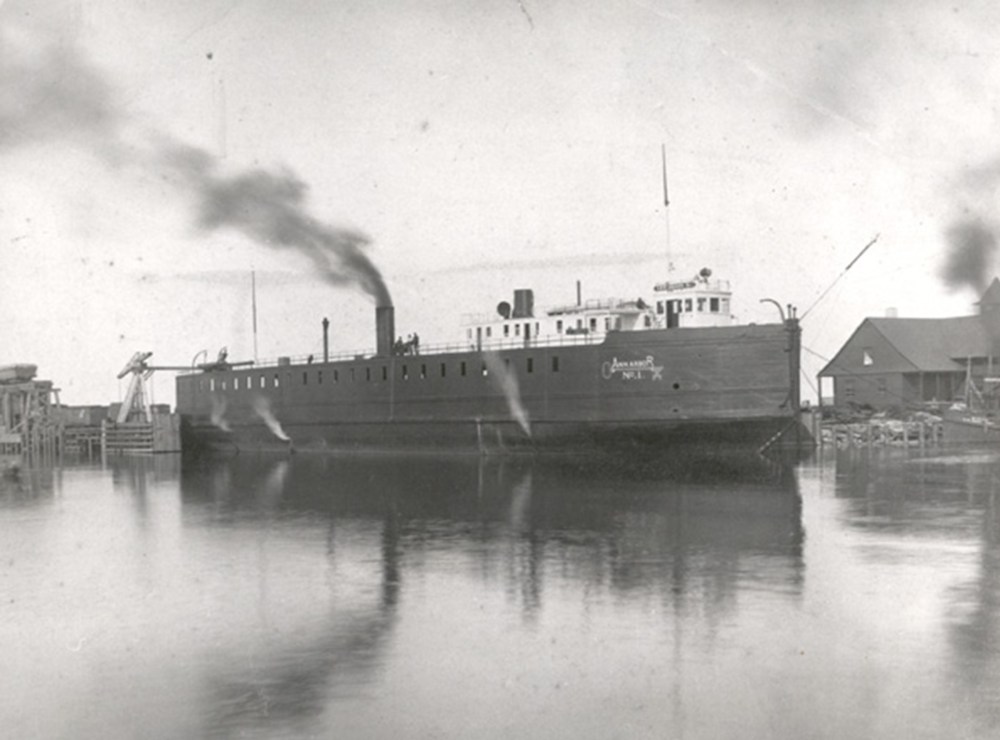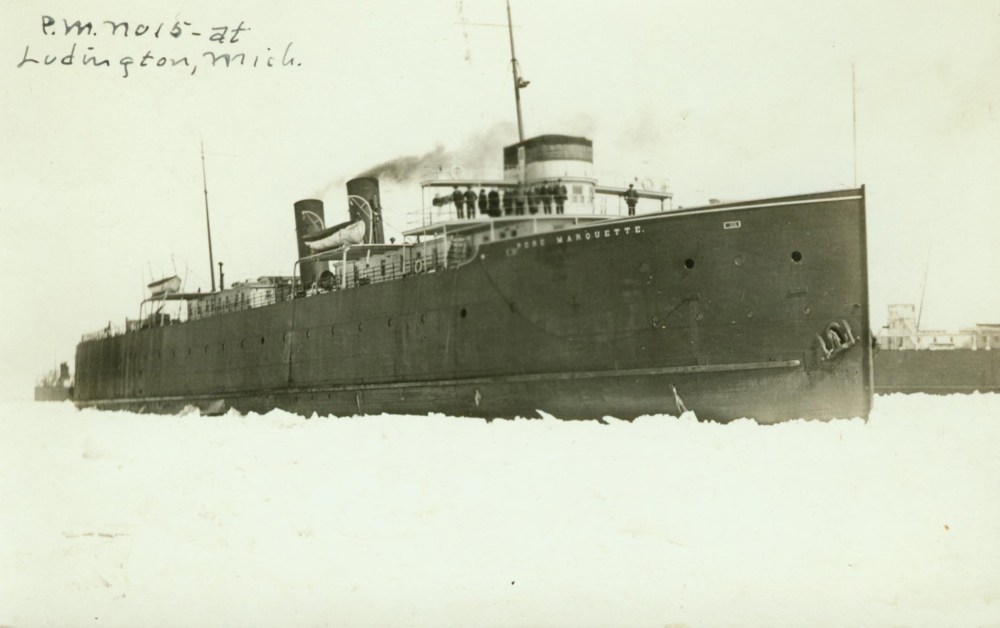The Pere Marquette, the first Ludington-based car ferry

By Rob Alway
In the mid-1890s, the Flint & Pere Marquette Railway began negotiating with the Wisconsin Central Railroad to construct a branch from its main line at Neenah-Menasha, Wisconsin to Manitowoc, where its rails would connect with tan F&PM ferry. The goal was to transport railcars across Lake Michigan on car ferries.
The railroad had been operating cross-lake break bulk service since 1875, a year after the railroad reached Ludington. Break-bulk steamers carried railway freight from shore to shore. Railcars at that time did not travel across the lake, so the contents of the cars were removed, loaded onto the break-bulk steamer, shipped across Lake Michigan, then re-loaded onto railcars waiting on the other shore.
The first railroad to offer car ferry service across Lake Michigan was the Toledo Ann Arbor & North Michigan Railway, predecessor of the Ann Arbor Railroad.

Ann Arbor No. 1, University of Detroit Mercy – Fr. Edward J. Dowling, S.J. Marine
The Toledo Ann Arbor & North Michigan was formed by James M. Ashley, former Governor of Montana, in 1884. It reached Frankfort, Michigan in 1892. Predecessor companies had built north from Toledo beginning in 1870. The line reached Copemish, Michigan, 267.5 miles from Toledo, in 1888. The following year, an independent road promoted by local interests, the Frankfort & South Eastern, reached Copemish from Frankfort — 23.5 miles — completing the line from Toledo to Frankfort. In 1892, Ashley acquired the Frankfort & South Eastern, bringing the entire line under TAA&NM management.
Frankfort had been an important port in the lumber trade for some years, and package freighters called there both in cross lake and coastwise service. Its harbor, Betsie Lake, is connected by a short channel to Lake Michigan. The harbor is extremely snug, offering protection against storms. Since the harbor mouth is quite far out into Lake Michigan, it is not troubled with concentrations of pack ice to an exceptional extent. Technically, the car ferry docks were located in Elberta, a small village on the south side of Betsie Lake adjacent to Frankfort.
Almost immediately upon taking over the Frankfort & South Eastern, Jan. 8, 1892, the Toledo Ann Arbor & North Michigan began to operate break-bulk service across the lake to Kewaunee, Wisconsin, the nearest major port on the Wisconsin shore. At this point in time, cross lake break-bulk service had been operating out of Ludington for 17 years.
The Lackawanna Railroad’s steamer Osceola made the first trip under lease to the TAA&NM. Osceola provided the service for the first season, along with the ships City of Marquette and Alice Stafford. Osceola could handle some 35 to 40 carloads of flour, the principle cargo, but the cost of transshipment amounted to $6 to $12 per car.
Ashley, even before completion of the railroad, had envisioned a service that could carry railcars across the lake to reduce the expenditure and to expedite the operation. He ordered a slip and other facilities built at Elberta.
He arranged with Frank E. Kirby to design a pair of wooden car ferries, which were then built at the Craig Ship Building Company of Toledo. The keel of the first, Ann Arbor No. 1 was laid on June 10, 1892 and the ship was launched Sept. 29 of the same year.
Since the ship was the first of a new type, a car ferry designed for lengthy trips on open water, it had many highly original features, some of which were successful and others of which were not. It had an oak hull, reported by those who sailed in it to have been particularly limber and flexible, and was steel sheathed to a point 4 feet above the water line. The new ship had a bow propeller for ice breaking and twin screws aft, making it the first triple screw ship in the American registry. It had three horizontal engines and three fire box boilers.
The Ann Arbor No. 1 was 260.4 feet in length and 53 feet in width. It was 14.7 feet in height. The ship was designed to load at the stern with a car deck that was open aft, which was a potentially dangerous arrangement. There was a risk of the car deck being swamped by a wave. This would be a major topic following the sinking of the Pere Marquette No. 18 almost two decades later.
The Ann Arbor No. 1 left on its first trip from Elberta to Kewaunee on Nov. 24, 1892.
Ann Arbor No. 2 was completed at the end of 1892 and made its debut in early January, 1893.

Robert Logan, 1911. Mason County Historical Society.
Other Kirby-designed ferries included the 215-foot wooden St. Ignace, built in 1888 by Detroit Dry Dock Co. for the Mackinac Transportation Co., the 288-foot wooden Sainte Marie, built in 1893 by Detroit Dry Dock Co., also for Mackinac Transportation Company in 1893, and the Shenango Nos. 1 and 2, which each entered service for the United States & Ontario Steam Navigation Company in 1895 and initially served on Lake Erie. The Shenango No. 2 was purchased by the Grand Trunk Milwaukee Carferry Company in 1898 and renamed the Muskegon. It was then purchased by the Pere Marquette Railway in 1901 and renamed Pere Marquette 16.
The F&PM was a few years behind the Ann Arbor. As a result of its negotiations with the Wisconsin Central Railway, the F&PM ordered a steel car ferry, designed by Robert Logan (1861-1918), a prominent naval architect of Cleveland who had immigrated to the U.S. from Scotland.
Logan’s original plan called for a four-tracked steel steamer of 337 feet with twin screws aft and, like all six of the wooden ferries that preceded her, a bow propeller. Apparently on the basis of the Ann Arbor’s unsatisfactory experience with bow propellers, the Flint and PM dropped the forward screw from the plans before the ship was built. The plans were also altered to cut back her spar deck slightly, as on modern carferries, rather than to have it extend all the way to the stern, as on the original Ann Arbor ferries.
The Pere Marquette was launched on Dec. 30, 1896 and arrived in Ludington on Feb. 13, 1897. It was then sent to Milwaukee for inspection. The ship had twin screws, steel hull, two stacks placed fore and aft and a single deck of cabins.
The Pere Marquette made its maiden voyage from Ludington to Manitowoc the evening of Feb. 16-17, 1897. It carried 22 freight cars and the private car of S.T. Crapo, general manager of the Flint & Pere Marquette Railway.
Rob Alway is Outside Marketing Representative for Lake Michigan Carferry and is also the Editor-in-Chief of Mason County Press in Scottville, Mich. He also serves on the Board of Directors of the Mason County Historical Society, in which much of the research from this article came from. The Mason County Historical Society owns and operates the Port of Ludington Maritime Museum along with the Rose Hawley Archives in downtown Ludington and Historic White Pine Village, south of Ludington in Pere Marquette Township.
Learn more about the history of the car ferries by visiting our friends at the Wisconsin Maritime Museum in Manitowoc, Wisconsin, the Door County Maritime Museum in Sturgeon Bay, Wisconsin, the Port of Ludington Maritime Museum in Ludington, Michigan, and the SS City of Milwaukee museum ship in Manistee, Michigan.

Pere Marquette 15, the first Ludington carferry. Mason County Historical Society Rose Hawley Archives.
